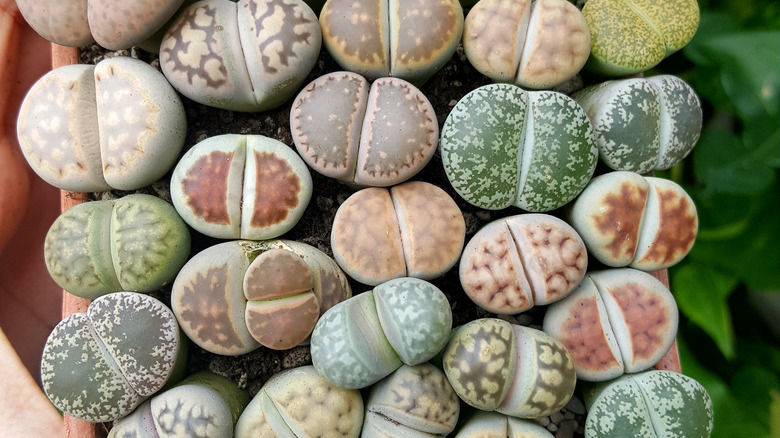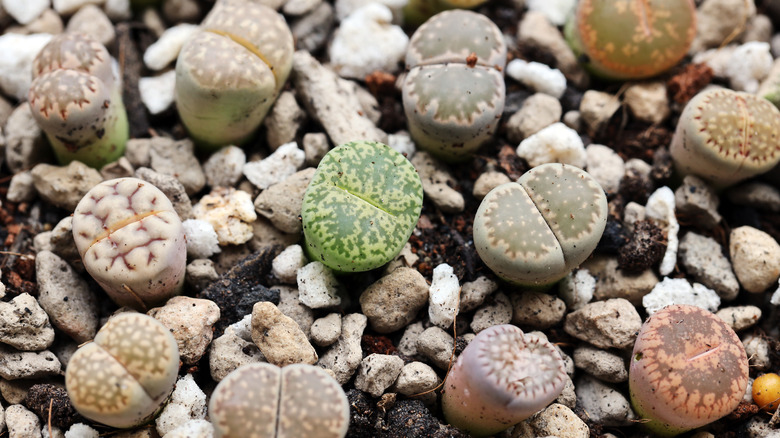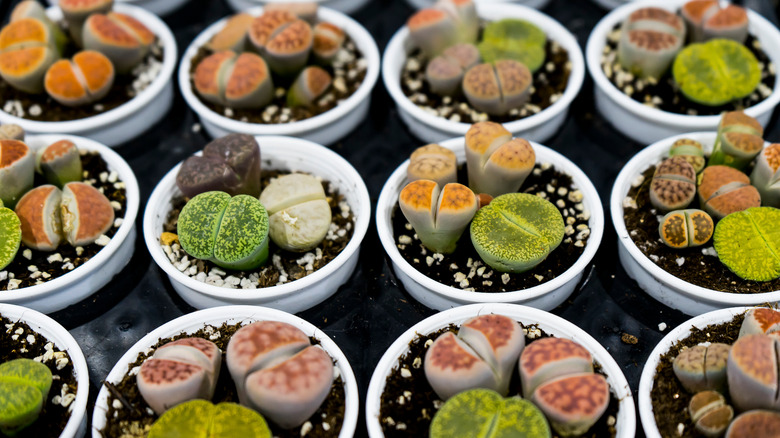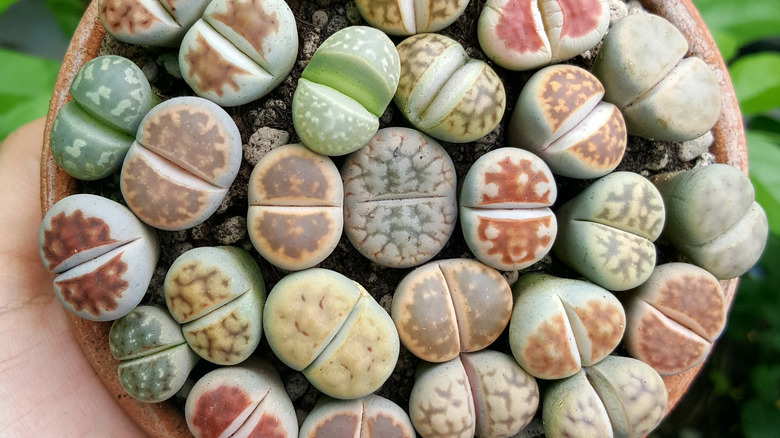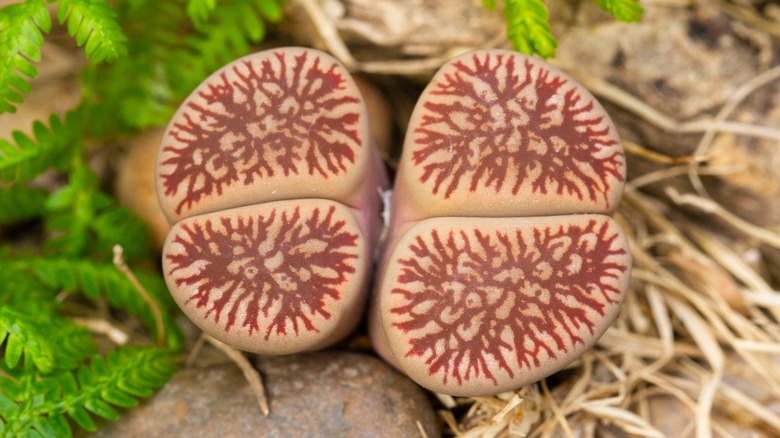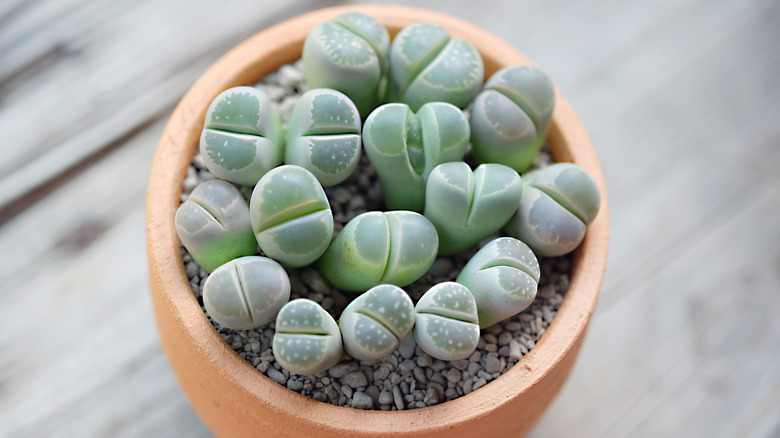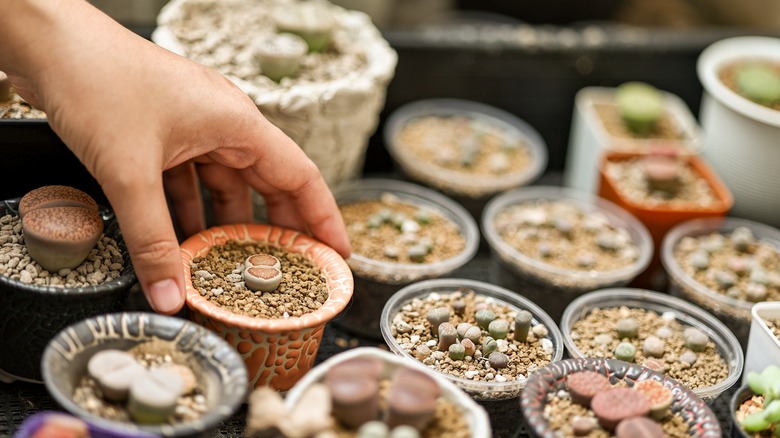How To Care For A Butt Plant
Lithops, also known as living stones, pebble plants, or butt plants, are a variety of succulents native to southern Africa, per Succulents Box. The plant gets its sassy nickname from its shape, which resembles a small rock or pebble, and looks like a small butt.
Butt plants are incredibly slow-growing succulents; their growth is often capped at 1 inch. As with all succulents, their care is either incredibly easy or somewhat tricky, depending on what type of plant owner you are and your experience. Succulents not only withstand neglect but also require it, as overwatering or fertilizing the plant can result in early death.
Due to their small size, these lovely succulents are typically grown in clusters together, creating a mini succulent garden indoors or outside. For this reason, they're also popular accent plants for full-scale succulent or rock gardens. Keep reading to learn how to grow and care for this peculiar succulent.
How to use butt plant in garden
Butt plants can be grown outdoors, but you should approach this differently depending on your climate. Fine Gardening says that butt plants can only be grown outdoors year-round in USDA hardiness zones 10 and 11. Although this may be true, many people in colder climates choose to move their butt plants outdoors in the summer or create an annual succulent garden.
Regardless if you're growing the plant outdoors in-ground perennially or just bringing them out for the summer, they require lots of sunlight, notes Epic Gardening. Those in deserts or with extremely hot sun exposure should try and get the plant some afternoon shade, but other than that, the succulent can sit under the full sun anywhere from five hours to all day — just turn it occasionally. Be sure to move the plant back indoors once it reaches 50 degrees or cooler.
Since butt plants are small and slow-growing, they don't make an excellent ground cover or border plant. However, they work wonderfully as an accent plant, either alone or mixed with other succulents in a succulent garden, whether in a container or in-ground. There are plenty of different succulents to plant alongside, such as haworthia varieties, agave plants, species of echeveria, and more, via Gardeners' World.
How to grow butt plant
Butt plants are commonly found at garden centers in the succulent section and aren't that expensive. But you may want to try your hand at propagating or growing your own lithops, which can be done either by growing them from seed, or through division, according to Succulents Box.
Growing butt plants from seed are the most popular way to grow this plant, but it takes a lot of patience, warns MasterClass. Begin by preparing a potting mix, a composition of potting soil and cactus mix, and perhaps some pebbles. It should be gritty, well-draining, and airy. Sprinkle the seeds over the soil, cover them with a light layer of sand, and keep them moist. Germination will take a few months. Once they sprout, divide them into 4-inch pots, and water them every two weeks.
Growing a butt plant via division is trickier since they have to be naturally already separating. If that's the case, gently remove the plant and its root system and cut — ensuring each plant has sufficient roots. Repot the butt plants in individual pots, making sure it's big and deep enough that the taproot system can grow without coiling.
How to care for butt plant
While caring for succulents seems intimidating for some plant owners, it's a pretty simple routine. Gardening Know How notes that the key is trying to mimic the plant's natural growing conditions, which, in the case of butt plants, is arid, with lots of sunlight and little water.
According to MasterClass, whether grown indoors or out, butt plants need as much full sun as possible, at least four to five hours. Be careful not to scorch the leaves, though. Rotate the plant, so it grows evenly. The only primary concern with caring for butt plants is overwatering them. The small plants only need to be watered every few months, but some people opt not to water them from fall to spring. Generally, they need to be watered once every two weeks or when the soil is thoroughly dry during the summer, and this can be reduced significantly for the rest of the year.
Butt plants can grow small flowers, but this will take many years. That being said, you can encourage blooms in a few ways. Withholding water during dormant months, primarily through winter, is one way to help them blossom. You can amp this up by feeding them with a diluted liquid cactus fertilizer once, either right before or during the first water of the season.
Butt plant varieties
According to Epic Gardening, there are roughly around 37 species in the lithops genus and an estimated 145 varieties within those species. Again, most of them have a remarkably similar shape resembling a butt. Here are just a few of those varieties:
- Lithops verruculosa: Known as the Rose of Texas, this variety can be found in red to grayish-green colors with distinctive red warts and blooms of pink, white, or yellow flowers.
- Lithops ruschiorum: Native to Namibia, this variety closely resembles a stone or rock, found in white, gray, or tan colors, and sports yellow flowers.
- Lithops viridis: Also known as the green rock-plant, this variety is a dark, grayish green color with either pink, green, or gray edges and bears yellow flowers.
- Lithops salicola: This variety, known as the salt-dwelling living stone, is found in the salt-rich areas of Namibia and South Africa and has gray leaves with a slight green tint, blossoming with white or yellow flowers.
- Lithops optica: Hailing from Namibia, this variety is unique for its bright purple-pink-colored surface and is more tolerant of overwatering than other varieties.
Are butt plants toxic?
The American Society for the Prevention of Cruelty to Animals writes that lithops are nontoxic to dogs and cats, with the Wisconsin Horticulture adding that they are also nontoxic to humans. Additionally, the latter notes that butt plants are a source of extra hydration due to the amount of water stored in their tiny leaves. The leaves of the plants are reported to have a slightly spicy, sweet scent to them.
There is no legitimate basis for eating the plant, and ingesting it should be avoided, and children and pets should be discouraged from doing so. As Epic Gardening notes, chemicals or pesticides on the plant's surface can be a serious cause for concern if ingested. Even if you're growing the plant indoors, the garden center you've purchased it from could have treated it with a chemical pesticide. If your pet or child ingests the plant, monitor them for any poisoning symptoms, and call their respective medical adviser or a poison control center if you notice anything concerning.
How to repot butt plant
Butt plants are incredibly slow growers, so repotting is not much of a concern with these plants. But the plant will eventually outgrow its pot, especially if potted with other butt plants or succulents, and will ultimately need to be repotted, via Succulents Box. Other issues, like soggy soil, pests or diseases, and the soil lacking nutrients, is also a cause for repotting.
To repot butt plants, look for a pot only slightly larger than its current home. The pot should be deep enough to handle the root system and wide enough for new growth, but not so big that the plant becomes overwhelmed or suffocated. Unglazed terracotta pots are ideal for increased water drainage.
Butt plants should be potted in a gritty, well-draining medium, such as cactus soil with additives like pebbles, sand, etc. Repotting should be done at the beginning of its growing season — roughly May, after the last threat of frost. Begin by gently removing the plant from its current pot and eliminating as much old dirt as possible. Hold the plant in its new pot so that it's at the same depth as before, and fill with soil. Tap the pot firmly to expose air holes and fill if necessary.
